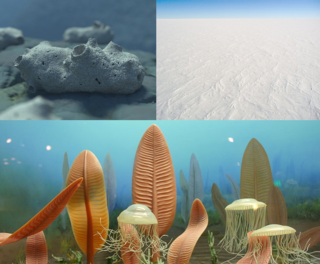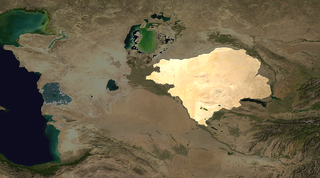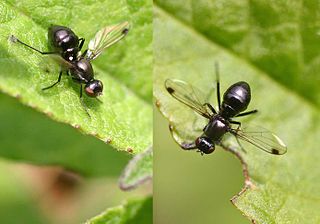Related Research Articles

The Neoproterozoic Era is the unit of geologic time from 1 billion to 538.8 million years ago.

The Kyzylkum Desert is the 15th largest desert in the world. Its name means Red Sand in Turkic languages. It is located in Central Asia, in the land between the confluent rivers Amu Darya and Syr Darya, a region historically known as Transoxania. Today it is divided between Kazakhstan, Turkmenistan and Uzbekistan. It covers about 298,000 km2 (115,000 sq mi).

The Palearctic or Palaearctic is the largest of the eight biogeographic realms of the Earth. It stretches across all of Eurasia north of the foothills of the Himalayas, and North Africa.

The Sepsidae are a family of flies, commonly called the black scavenger flies or ensign flies. Over 300 species are described worldwide. They are usually found around dung or decaying plant and animal material. Many species resemble ants, having a "waist" and glossy black body. Many Sepsidae have a curious wing-waving habit made more apparent by dark patches at the wing end.

The KamchatkaPeninsula is a 1,250-kilometre-long (777 mi) peninsula in the Russian Far East, with an area of about 270,000 km2 (104,248 sq mi). The Pacific Ocean and the Sea of Okhotsk make up the peninsula's eastern and western coastlines, respectively. Immediately offshore along the Pacific coast of the peninsula runs the 10,500-metre-deep (34,449 ft) Kuril–Kamchatka Trench.

Fauna is all of the animal life present in a particular region or time. The corresponding term for plants is flora, and for fungi, it is funga. Flora, fauna, funga and other forms of life are collectively referred to as biota. Zoologists and paleontologists use fauna to refer to a typical collection of animals found in a specific time or place, e.g. the "Sonoran Desert fauna" or the "Burgess Shale fauna". Paleontologists sometimes refer to a sequence of faunal stages, which is a series of rocks all containing similar fossils. The study of animals of a particular region is called faunistics.

Lake Khanka or Lake Xingkai, is a freshwater lake on the border between Primorsky Krai, Russia and Heilongjiang province, Northeast China.

Tineidae is a family of moths in the order Lepidoptera described by Pierre André Latreille in 1810. Collectively, they are known as fungus moths or tineid moths. The family contains considerably more than 3,000 species in more than 300 genera. Most of the tineid moths are small or medium-sized, with wings held roofwise over the body when at rest. They are particularly common in the Palaearctic, but many occur elsewhere, and some are found very widely as introduced species.

The Kanin Peninsula is a large peninsula in Nenets Autonomous Okrug, Russia.

Pechora Sea, is a sea at the northwest of Russia, the southeastern part of the Barents Sea. The western border of the sea is off Kolguyev Island, while the eastern border is the western coasts of Vaygach Island and the Yugorsky Peninsula, and the northern border the southern end of Novaya Zemlya.

Limacidae, also known by their common name the keelback slugs, are a taxonomic family of medium-sized to very large, air-breathing land slugs, terrestrial pulmonate gastropod molluscs in the superfamily Limacoidea.

Otsheria is an extinct genus of anomodont from the Permian of Russia. Otsheria had a 10 centimetres (3.9 in) long skull.
Bukobaja is an extinct genus of mastodonsaurid temnospondyl from the middle Triassic of Russia. It contains a single species, Bukobaja enigmatica. Bukobaja mainly occurs in the Bukobay Svita as part of the Ladinian?-age "Mastodonsaurus fauna", a section of Russian Triassic biostratigraphy characterized by "Mastodonsaurus" torvus. It was also present in the underlying Donguz Svita. Bukobaja appears to be a valid genus similar to, yet distinct from, Mastodonsaurus. Despite appearing to possess several unique features, Bukobaja is still known from very few remains. This has led to difficulties in determining its relations more precisely than "Mastodonsauridae incertae sedis". It has also been compared to trematosaurids.
Energosuchus is an extinct genus of rauisuchian. Fossils are present from the upper Karyomayol and lower Synya Formations outcropping along the banks of the Bolshaya Synya river in the Timan-North Urals region in northern European Russia, as well as from the Bukobay Formation in the southern part of Bashkortostan in the southern Urals of European Russia. Both localities date back to the Ladinian stage of the Middle Triassic.
Tsylmosuchus is an extinct genus of potentially dubious ctenosauriscid archosauriform reptile known from Western Russia. Fossils referred to Tsylmosuchus occurred over a wide area in sediments corresponding to the Induan and Olenekian stages of the Early Triassic. Most of these fossils are fragmentary neck vertebrae which were originally reported as sharing similarities with crocodile-line archosaurs (pseudosuchians) such as Mandasuchus. As a result, Tsylmosuchus was first described as part of the family Rauisuchidae, making it supposedly one of the oldest known archosaurs. However, its fragmentary remains do not show any of the distinguishing features of rauisuchids or even pseudosuchians in general, so Tsylmosuchus has more recently been interpreted as an indeterminate archosauriform. Although three species of Tsylmosuchus have been named, they lack diagnostic traits and are probably not distinct from each other.
Parasumina is an extinct genus of anomodont known from the late Capitanian age at the end of the middle Permian period of European Russia. The type and only species is Parasuminia ivakhnenkoi. It was closely related to Suminia, another Russian anomodont, and was named for its resemblance. Little is known about Parasuminia as the only fossils are of fragmentary pieces of the skull and jaw, but the known remains suggest that its head and jaws were deeper and more robust than those of Suminia, and with shorter, stouter teeth. However, despite these differences they appear to have been similar animals with a similarly complex method of processing vegetation.
Peter Yulievich Schmidt was a Russian and Soviet zoologist, ichthyologist and museum curator.

Dipsocoridae are a family of heteropteran bugs known as jumping ground bugs. There are about 30 widely distributed species which are placed in three genera. Fossils from Eocene amber have also been placed in the family.

Khorotherium is a genus of extinct mammaliaforms. The type and only species, Khorotherium yakutensis, is known from the Lower Cretaceous Batylykh Formation in Western Yakutia, Russia. It belongs to the family Tegotheriidae from the order Docodonta, alongside Sibirotherium from the same region, it is amongst the youngest known docodonts.